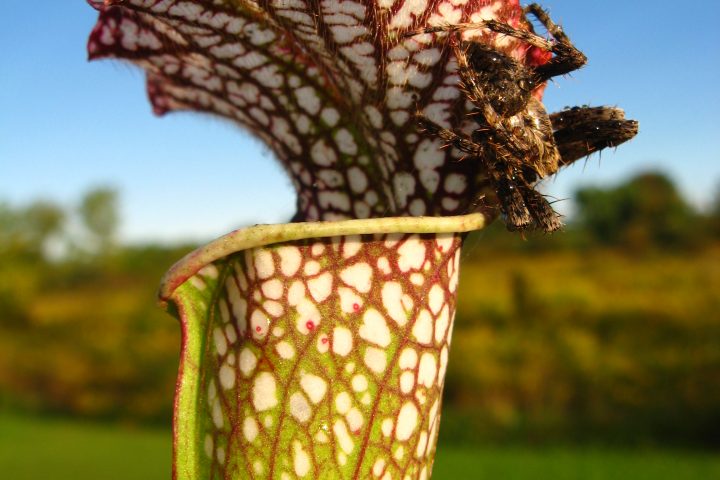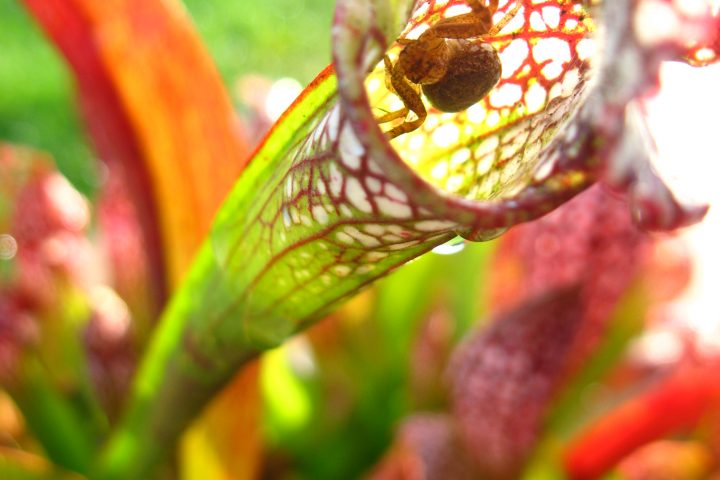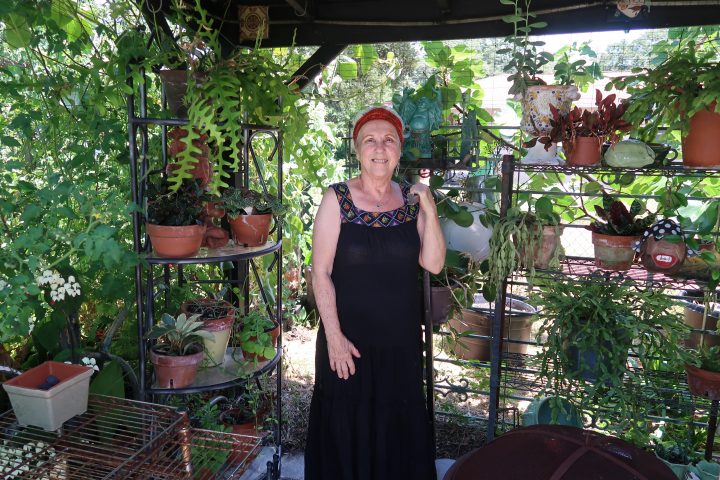I just love a themed garden. I really enjoy a garden when its theme is not overt. Plants can be grouped by their color, texture, or height. In pockets of my yard I grow exclusively blue flowers. In another, I group plants that possess variegated leaves. By my back porch I grow Colocasias and similar looking leafed Alocasia. For eccentricity you can also group plants by their common name. Here are my favorite feline inspired flora.
Cat’s Whiskers (Orthosiphon aristatus), are hardy in Zones 9a to 11. Orthosiphon is Greek for “upright tube” and aristatus is Latin for “with ears”. Cat’s Whiskers add a tropical flare to your yard. In North Florida this plant can be grown on the patio or as an annual. The plant always demands attention with its spikes of flowers whose long stamens look like kitty whiskers. The flowers can either be white or lavender. Due to its leaf and flower shape, cannas, plumbago or pentas would complement an arrangement nicely.
Cat’s Whiskers attract butterflies and are deer and rabbit resistant. They do well in part to full sun and have average watering needs. Deadheading will keep this tropical perennial looking great year-round. To propagate, collect the seedheads or take cuttings of softwood and place them in water and sunlight. Cat’s Whiskers is a mint relative and is used to make medicinal Java tea. The leaves have been said to help with high blood pressure, rheumatic fever, gout, and renal inflammation. Consult with your doctor before you start brewing things from your yard. Java tea (Orthosiphon aristatus synonym O. stamineus) is readily available at supermarkets and grocery stores. Whether you drink it or admire it, you should add it to your collection. My neighbors say they are getting constantly getting compliments about this cat christened plant.
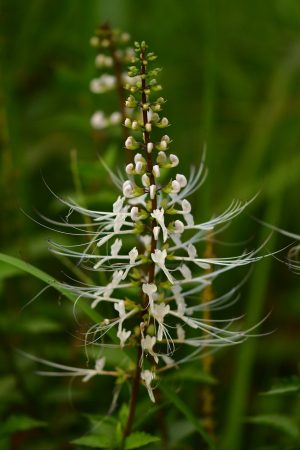
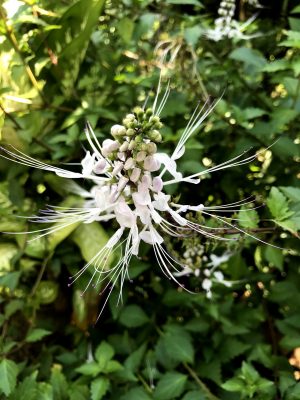
Leopard’s are a big cat and the leopard flower or blackberry lily (Iris domestica) are hardy and bloom during the summer. Technically not a leopard, blackberry, or lily this iris relative has orange sword-shaped leaves with red spots. I have a hedge of them in the center of my yard. I am constantly collecting seeds and propagating them to fill up the area to create a three-foot-tall orange centerpiece. This area is adjacent to my blue garden. They do best in full sun but can still produce a ton of flowers in the shade.

The leopard plant (Farfugium japonicum) not to be confused with the leopard flower, is a shade tolerant clumping perennial. The leaves are very large and would do best interspersed with other ground covers, because they look so heavy on their own. They only grow two feet high and can tolerate poor drainage and even some flooding. Solid varieties can be found at the big box stores for around $15 for a 1.5-gallon pot. I would hold out for a plant show when ‘Argenteum’ ‘Kaimon Dake’ ‘Aureomaculatum’ varieties are available. These varieties are strikingly multicolored or spotted much like a leopard.
The most famous large cat is the lion. Lion’s ear or lion’s paw (Leonotis leonurus) is another great cat themed option for your garden. Don’t you just love that scientific name: leo. Leonotis is Greek for lion’s ear and leonurus is Greek for lion colored. While I was in South Africa I didn’t see any highlighter-orange lions, but I did see this plant on safari. In my yard I have 3 specimen plants spread about. I must stake them many times a year, when there is a heavy rain. The plant can reach five to six in height and some gardeners say even higher. The herbaceous stems have dark green leaves. When they bloom they have fuzzy orange tubular flowers which are favored by hummingbirds.
Cattails, yes, that aquatic corndog looking plant, can be grown in your yard and look nice if you have a water feature. Typha domingensis (southern cattail) and Typha latifolia (common cattail) are both native to Florida. As you may have witnessed cattails are vigorous fast-spreading plants. In addition to looking great, they are also edible. Their rhizomes can be eaten raw or cooked, the young shoots taste like asparagus, the young flowering stem like sweet corn and the pollen can be added to flour.
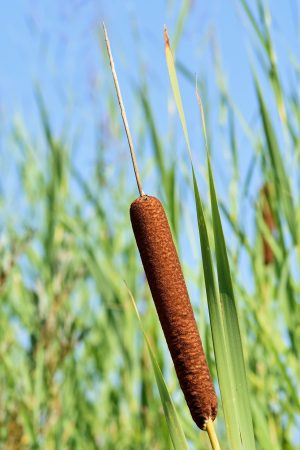
There are a lot of varieties of catmint which offer a gentle colored ground cover. Japanese catmint Nepeta × subsessilis has the largest flower spikes which can reach 8 inches long and 3 inches wide. ‘Blue wonder’ Nepeta x racemose is a miniature which has wrinkled grey-green leaves. Most catmints are perennials up until Zone 8 or 9. Like catnip, I grow catmint during the winter months.
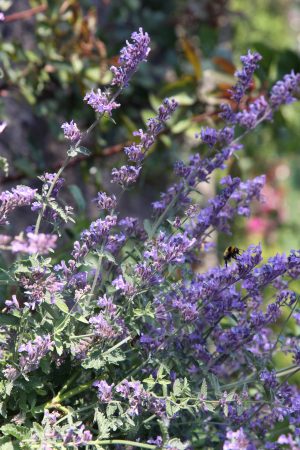
Catnip (Nepeta cataria) is the perennial herb whose chemical compounds drive cats crazy. I can keep it alive up until May here in Central Florida due to the heat and humidity. Catnip can be used as a tea for humans to calm nerves as it acts as a mild sedative – the opposite effect for our feline friends. When my cats get a treat of fresh catnip they start biting nearby ankles and scratching the carpet. According to the Florida Institute of Neuroscience one to two teaspoons of dried catnip per one cup of water can be used for insomnia or to sooth an upset stomach caused by stress. In the 1960’s one publication reported that catnip caused a psychedelic high in humans, but it turned out that the researchers gave the participants marijuana, not catnip! Lemon catnip is not favored by cats and has a great scent and looks great with its silvery foliage. Seeds may take a while to germinate, but the crop will take off and is easy to grow.
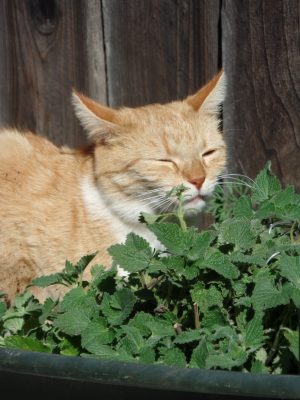
Whatever you do, don’t grow cat’s claw vine (Dolichandra unguis-cati) even though it has a cat name! Keep it out of you feline inspired flora beds. With its cute 3-pronged claw-like climbing appendages it will take over, reaching 50 feet in length. Cat’s claw vine or cat’s claw creeper is a Category I exotic invasive by Florida’s Exotic Pest Plant Council.
Having a themed garden or section of the yard is entertaining. It also helps you choose specimens when you feel overwhelmed at a plant show. What subject matter inspires your garden?
To learn more about homesteading, cats and plants, check out my newest book: 99½ Homesteading Poems


